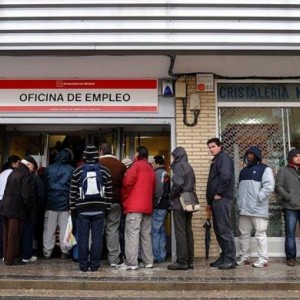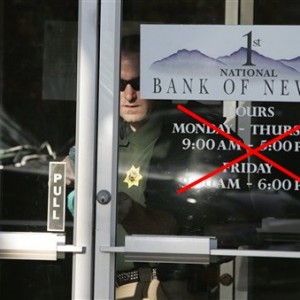 Have you ever noticed how almost all U.S. bank closings are now announced over the weekend? It is almost as if someone wants to keep the increasing number of bank closures out of the news cycle as much as possible. The Obama administration continues to use phrases like “green shoots” and “economic recovery”, but the truth is that the U.S. banking system is in the middle of a meltdown. On Friday, federal regulators shut down 7 more banks. That means that the total number of U.S. bank failures has reached 103 for 2010 so far. Last year (which was a really bad year for bank closings), we did not break 100 until October. Of course federal officials promise that “the worst is almost over”, but can we really trust anything that they tell us at this point?
Have you ever noticed how almost all U.S. bank closings are now announced over the weekend? It is almost as if someone wants to keep the increasing number of bank closures out of the news cycle as much as possible. The Obama administration continues to use phrases like “green shoots” and “economic recovery”, but the truth is that the U.S. banking system is in the middle of a meltdown. On Friday, federal regulators shut down 7 more banks. That means that the total number of U.S. bank failures has reached 103 for 2010 so far. Last year (which was a really bad year for bank closings), we did not break 100 until October. Of course federal officials promise that “the worst is almost over”, but can we really trust anything that they tell us at this point?
When it comes to the health of the U.S. banking system, the statistical trends certainly do not look promising.
At the end of 2008, there were 252 U.S. banks on the FDIC’s problem list.
At the end of 2009, there were 702 U.S. banks on the FDIC’s problem list.
About halfway through 2010, FDIC Chairman Sheila Bair said that 775 banks (approximately 10% of all U.S. banks) were on the problem list.
Does anyone else notice a trend developing?
It is time for everyone in the financial world to admit that the U.S. banking system is dying.
Do you know if your bank if on the problem list?
You might want to go check.
Not that your money is going to suddenly disappear.
Even if your local bank fails, the FDIC will guarantee your bank account, right?
Yes, it will.
But the FDIC is far from healthy at this point.
The FDIC is backing approximately 8,000 U.S. banks that have a total of about $13 trillion in assets with a deposit insurance fund that is pretty close to empty.
Well, actually “empty” is not quite the right word.
It was recently reported that the FDIC’s deposit insurance fund is sitting at negative 20.7 billion dollars.
And the FDIC estimates that the seven bank failures on Friday will reduce the fund by another $431 million.
Ouch.
The truth is that the FDIC is rapidly turning into a gigantic financial black hole.
The red ink just seems to be endless.
The FDIC now estimates that their funds will experience a $60 billion reduction due to additional bank closings between now and 2014.
And to be honest, that figure is way too optimistic.
So who is going to bail the FDIC out?
The same source that bails everyone out.
The U.S. taxpayers.
But isn’t that bad?
Yes, all of these bailouts are going to cause the U.S. national debt to continue to explode, but what else can we do?
Are we just going to shut down the FDIC?
That wouldn’t go over too well with anyone.
No, the truth is that this is the system that we have built.
All the crap flows downhill and ultimately ends up in the laps of U.S. taxpayers.
The bad news is that it looks like large numbers of banks are going to continue to fail.
You see, right now the American people are simply not doing a very good job of paying their bills.
During the first quarter of 2010, the total number of loans at U.S. banks that were at least three months past due increased for the 16th consecutive quarter.
Just think about that for a moment.
Would you consider 16 in a row to be a trend?
In an economic system built on credit, it is absolutely imperative that most people pay their debts or the whole thing will come crashing down very quickly.
And right now it is undeniable that things are unraveling at a staggering pace.
So who is benefiting from all this?
Well, there is one segment of the banking industry that is actually performing quite nicely in the midst of all of this chaos.
Many of the largest banks in the U.S. have been reporting very large profits as they gobble up larger and larger shares of the U.S. banking market.
In a previous article entitled “Are We About To Witness The Greatest Banking Consolidation In U.S. History?”, we noted the rapidly growing power of America’s megabanks….
Back in 2000, the “Big Four” U.S. banks – Citigroup, JPMorgan Chase, Bank of America and Wells Fargo – held approximately 22 percent of all deposits in FDIC-insured institutions. As of June 30th of last year that figure was up to 39 percent.
The Founding Fathers of this country warned us of the danger of big banks getting too much power, but we have not listened to their warnings.
Now we have monolithic global banks that are so immense in size that we seem almost powerless to control them.
In fact, the six biggest banks in the United States (Goldman Sachs, Morgan Stanley, JPMorgan Chase, Citigroup, Bank of America, and Wells Fargo) now possess assets equivalent to 60 percent of America’s gross national product.
The truth is that these sharks aren’t shedding any tears when your local banks die off.
Why?
Because they know that many of the customers from the banks that have died will soon come their way.
The reality is that all of the legislation and regulations implemented during the past 30 or 40 years have rigged the game massively in favor of the big global banks.
So dozens upon dozens of smaller banks are going to continue to die and the megabanks are going to continue to eat up increasingly larger portions of market share.
So if you still have money in a small local bank, enjoy it while you can.
From now on, the small bank in America is an endangered species.













